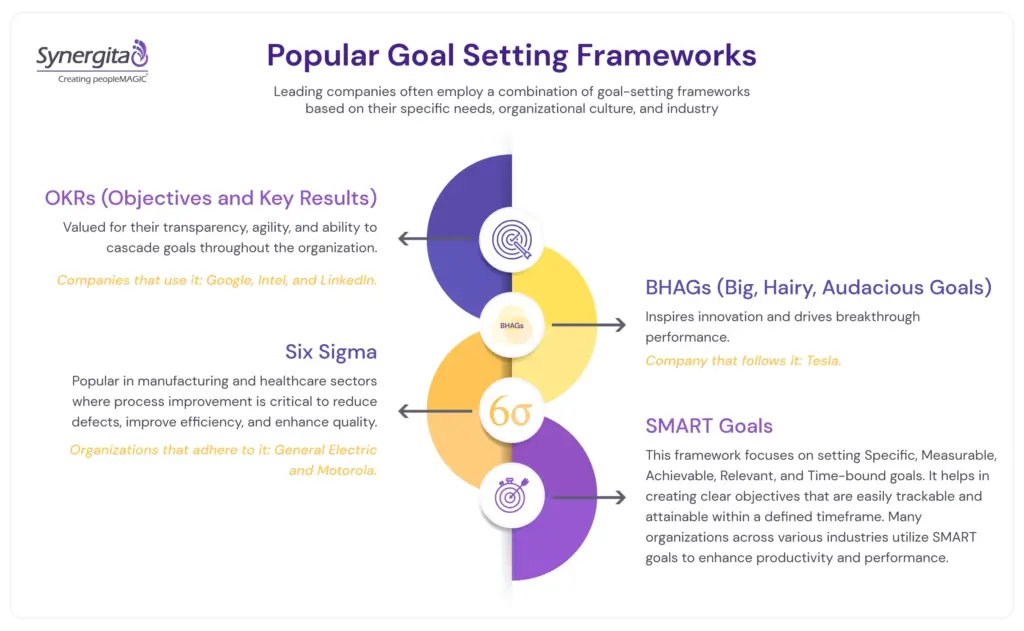7 Steps to Effective Goal Setting
“A goal properly set is halfway reached,” the words of American motivation speaker Zig Ziglar ring true for every organization that has its eyes set on a lofty vision. For businesses, it means working with teams and bringing them together to make the company’s vision a reality. And it pays!
Nearly 22% increase in employee performance is observed when their goals are aligned with organizational priorities, as per research by Gartner. This alignment fosters adaptability to changing needs, facilitates peer coordination, and encourages self-accountability, resulting in enhanced productivity and effectiveness within the organization. This blog dives into what to keep in mind during goal setting and answers all your ifs and buts.
What is goal setting?
Goal setting involves the deliberate process of defining goals, breaking them down into actionable steps, and devising strategies to achieve them. By setting clear, challenging, and achievable goals through effective goal setting, individuals and organizations can enhance their focus, motivation, and performance toward desired outcomes.
In the 1960s and 1970s, Edwin Locke and Gary Latham conducted seminal research on goal-setting theory, highlighting the importance of setting challenging yet achievable goals to motivate performance. Their work demonstrated that setting specific, difficult goals led to higher levels of performance compared to vague or easy goals.
Importance of Goal setting
Today, setting goals isn’t just a whim, it’s a necessity that fuels your journey from aspiration to achievement.
- Clarity and Focus: Goals provide that compass, guiding businesses towards their desired outcomes. For instance, a tech startup might set a goal to increase user engagement by 30% within six months, providing clear direction for product development and marketing efforts.
- Alignment: Just as a conductor harmonizes the orchestra, goals align the efforts of individuals and teams towards a common purpose. Take the example of a firm expanding into new markets. By setting goals to open 10 new stores by the end of the year, each department — from real estate to operations to marketing — knows its role in achieving the company’s expansion objectives.
- Motivation and Engagement: Goals act as fuel for motivation, igniting the drive to excel. Consider a sales team striving to exceed quarterly targets. By setting ambitious yet attainable sales goals and offering incentives for surpassing them, the team is inspired to push beyond their limits, fueling a culture of high performance and dedication.
- Measurable Progress: Think of goals as milestones on a journey—they mark progress and guide the way forward. For a manufacturing company aiming to reduce production defects, setting a goal to achieve a defect rate below 1% provides a tangible benchmark for quality improvement efforts.
- Accountability and Responsibility: Goals foster a sense of ownership and accountability among employees. If a marketing team is tasked with launching a new product campaign, then setting specific goals for website traffic, lead generation, and conversion rates allows each team member to take part in the campaign’s success. This shared accountability ensures that everyone pulls their weight to achieve the desired outcomes.
- Strategic Adaptability: Goals that are flexible and adaptable enable businesses to pivot and respond to changing market conditions. For instance, an e-commerce retailer facing stiff competition may adjust its sales goals mid-year to focus on niche markets or introduce new product lines, ensuring continued growth and relevance in the market.
Seven Tips for Effective Goal Setting
Goal setting hinges on several factors and the onus is on the leadership to steer the company toward success. Keep these points in mind when strategizing for your company:
1. Be clear and break it down: Whether it’s launching a new product line or entering a new market, clear objectives serve as the guiding star. But you also need milestones to measure progress. By establishing key results, you transform lofty aspirations into manageable checkpoints, making the journey more achievable and the destination more attainable.
2. Align goals with organizational priorities: Ensure that individual goals are aligned with the organization’s overarching strategic objectives. Disconnect between personal goals and organizational priorities can lead to demotivation and disengagement among employees. By establishing this alignment, collaboration among peers is fostered, enabling effective coordination and self-accountability. Consequently, productivity is enhanced within the workforce.
3. Involve employees: Rather than imposing goals from the top down, involve employees in the goal-setting process. Encourage frequent discussions about business objectives and purpose. Research indicates that 70% of surveyed employees said their sense of purpose is defined by their work, and the leading driver of performance and productivity is the sense of purpose work provides.
4. Consider inter-dependencies: Recognize that goals often involve collaboration and interdependence among different teams and stakeholders. When setting goals, consider the key collaborators necessary for success and invite their input to identify interdependencies and align objectives. For instance, leaders at a technology firm could convene meetings with cross-functional teams to share goals, discuss interdependencies, and ensure integration for achieving shared objectives.
5. Conduct check-ins: Rather than relegating goal setting to a once-a-year ritual followed by a year-end review, integrate ongoing check-ins quarterly or even weekly. These regular checkpoints facilitate discussions on progress, obstacles, developmental objectives, and personal aspirations. This approach not only fosters greater engagement and connection but also ensures that goals remain relevant and adaptable to evolving circumstances.
6. Balance short-term with long-term: Differentiate between performance goals and learning goals based on the nature of the work and the desired outcomes. Performance goals focus on achieving specific targets in the short term while learning goals emphasize the process of gaining understanding and applying knowledge for long-term impact.
7. Celebrate achievements: Finally, let’s raise a toast to success, and failure. By celebrating achievements — no matter how small — and learning from setbacks, you not only build resilience, but also transform setbacks into stepping stones for future success.

Why OKRs make Goal Setting Easy for Every Business
With the elegant blend of simplicity and sophistication, OKRs, offer a streamlined approach that cuts through the clutter, allowing businesses to focus on what truly matters. By distilling goals into clear objectives and measurable key results, OKRs provide a laser-sharp focus that keeps teams on track and aligned with the company’s overarching vision.
We at Synergita understand that OKRs aren’t just about setting goals, they’re about establishing a culture of transparency, collaboration, and continuous improvement. With OKRs, businesses can easily cascade objectives from top to bottom, ensuring everyone is rowing in the same direction. Plus, the flexibility of OKRs allows teams to adapt and pivot with ease, fostering agility in an ever-evolving landscape. In essence, OKRs are the secret sauce that transforms goal setting from a daunting chore into a strategic advantage, empowering businesses to thrive and conquer their objectives with finesse.
Want to know more about how your team’s productivity can increase? Try Synergita OKR for free and know the difference!
